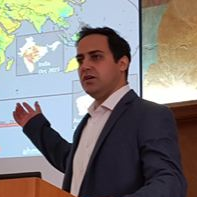Soil Moisture Remote Sensing Across Scales
A special issue of Remote Sensing (ISSN 2072-4292). This special issue belongs to the section "Remote Sensing in Geology, Geomorphology and Hydrology".
Deadline for manuscript submissions: closed (31 August 2018) | Viewed by 81909
Special Issue Editors
Interests: microwave remote sensing; soil moisture; vegetation optical depth; biomass; machine learning
Special Issues, Collections and Topics in MDPI journals
Interests: soil moisture; hydrology; assimilation; microwave remote sensing; physical modeling; energy budget
Special Issues, Collections and Topics in MDPI journals
Interests: microwave remote sensing techniques and algorithms; global water cycle; cryosphere
Special Issues, Collections and Topics in MDPI journals
Interests: microwave remote sensing; soil moisture; soil freeze–thaw; application of satellite information in hydrology and water management
Special Issues, Collections and Topics in MDPI journals
Special Issue Information
Dear Colleagues,
Soil moisture plays an important role in the water, carbon and energy cycles. The amount of moisture in soil is an important variable to understand the coupling of the surface and the atmosphere. It is a key component in improving weather forecasting and climate models, and it has been recognized as an Essential Climate Variable. Assimilation of soil moisture to land surface models has resulted in increased understanding of processes controlling the energy exchange at the land-atmosphere interface. It is also used to improve rainfall estimations, drought monitoring, land slide prediction and flood forecasting.
Thanks to a number of sensors of different characteristics, it is possible to study the soil moisture content at different spatial scales from tens of kilometres (ASCAT/MetOp, SMAP, SMOS, AMSR-2/GCOM-W, MWRI/FY-3...) to tens/hundreds of meters (Sentinel-1, Radarsat-2, GF-3...), or even at sub-meter resolution using drones. By combining data from different instruments with sensors across the electromagnetic spectrum (different microwave bands, visible, infra-red, active and passive) it is possible to improve the quality of the soil moisture retrievals obtained with a single instrument. Using the currently-available satellites, soil moisture can be monitored at daily frequency and disseminated in near-real-time. Finally, a harmonised processing of observations from different sensors can provide long-term soil moisture records for climate studies.
In this Special Issue, we welcome studies on remote sensing of soil moisture across different spatial and temporal scales. We also welcome studies addressing new missions, such as the Water Cycle Observation Mission (carrying a one-dimensional synthetic-aperture microwave radiometer), possible SMOS and SMAP follow-up missions, and any other missions deploying L-Band instruments. The studies can deal with the retrieval of soil moisture, the validation of remote sensing measurements and their use for scientific research or operational applications.
Potential topics include but are not limited to the following:
- Retrieval algorithms, in particular using multi-wavelength, active and passive data, both based on physical models and data-driven methods
- Downscaling satellite soil moisture merging data from sensors with different spatial resolutions
- Approaches for the harmonised processing of data coming from different sensors to construct longer, coherent, soil moisture records
- Validation of satellite soil moisture products, in particular using new techniques for up-scaling and new measurements.
- Applications of remotely sensed soil moisture data including data assimilation and disaster assessment
Dr. Nemesio Rodríguez-Fernández
Dr. Ahmad Al Bitar
Dr. Andreas Colliander
Dr. Tianjie Zhao
Guest Editors
Manuscript Submission Information
Manuscripts should be submitted online at www.mdpi.com by registering and logging in to this website. Once you are registered, click here to go to the submission form. Manuscripts can be submitted until the deadline. All submissions that pass pre-check are peer-reviewed. Accepted papers will be published continuously in the journal (as soon as accepted) and will be listed together on the special issue website. Research articles, review articles as well as short communications are invited. For planned papers, a title and short abstract (about 100 words) can be sent to the Editorial Office for announcement on this website.
Submitted manuscripts should not have been published previously, nor be under consideration for publication elsewhere (except conference proceedings papers). All manuscripts are thoroughly refereed through a single-blind peer-review process. A guide for authors and other relevant information for submission of manuscripts is available on the Instructions for Authors page. Remote Sensing is an international peer-reviewed open access semimonthly journal published by MDPI.
Please visit the Instructions for Authors page before submitting a manuscript. The Article Processing Charge (APC) for publication in this open access journal is 2700 CHF (Swiss Francs). Submitted papers should be well formatted and use good English. Authors may use MDPI's English editing service prior to publication or during author revisions.








